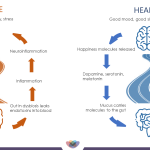
As you prepare to kick off your favorite outdoor summer activities, you should pay attention to a few more things, like how to tell if your body is dangerously close to becoming dehydrated and how to listen to your body's signals. Pay attention and take good care of yourself, and you'll be free to enjoy your hikes, cookouts, and poolside lounging without any pesky consequences.
How Much Heat Can Your Body Handle, and What Happens When It's Too Much?
104 to 122 degrees Fahrenheit. When the body's temperature exceeds 99 or 100 degrees, a condition known as hyperthermia can occur. Any extensive time spent outside in hot weather (like landscaping, sports practice, or simply sitting in your backyard), even if the heat isn’t extreme, can cause the body to produce heat faster than it can release.
Heat Diminishes Heart Function
Any amount of heat will cause your heart to work harder to keep your body cool. Whether the temperature is soaring or you're working up a sweat enjoying the outdoors, your heart has to work harder to keep your body running as it should. In each of these scenarios, hyperthermia—which occurs in three stages—can happen as your body becomes too hot.
Three Heat-Related Conditions Leading to Hyperthermia
Heat cramps
These are the first signs of a heat-related illness and are painful muscle spasms that occur during or after intense exercise in hot weather.
The symptoms and signals of heat cramps include:
- Heavy sweating
- Fatigue
- Thirst
- Spasms or cramps in the legs or the abdomen
Heat Exhaustion
If not treated properly, heat cramps can progress to heat exhaustion. In some cases, individuals may not experience heat cramps before developing heat exhaustion.
Heat Exhaustion
If not treated properly, heat cramps can progress to heat exhaustion. In some cases, individuals may not experience heat cramps before developing heat exhaustion.
Symptoms of heat exhaustion include:
- Heavy sweating
- Thirst
- Rapid pulse
- Weakness
- Nausea
- Dizziness
Heat Stroke
If heat exhaustion is left untreated, it can escalate to heat stroke or sunstroke, a life-threatening condition that requires immediate medical attention.
Symptoms of heat stroke include:
- Rapid breathing
- Fainting, loss of consciousness
- Racing heartbeat
- Changes in mental health or behavior (including confusion)
- Throbbing headache
- Nausea
- Dizziness
- Body temperature above 103°F
- Hot, red, dry, or damp skin
Tips to Beat the Heat This Summer
- Hydrate a couple of hours before you head outside. Many marathon runners opt to hydrate themselves with 16 ounces of water or an electrolyte drink approximately two hours before their race, guaranteeing proper absorption of fluids into their system. We like this tip because when it's hot out, it will prepare your body and allow it to keep itself cool.
- Keep drinking water while active. Our bodies are made up of 55% to 60% water. It helps move toxins and waste from our cells and regulates our body's heating and cooling systems. Simply put, hydration is vital to preventing heat-related illnesses. Drinking water at 15–20-minute intervals while active in the heat is recommended to replenish fluids lost through sweat. But it's important not to drink more than 48 ounces per hour (or 2.84 standard single-use plastic water bottles). Too much water at once can be deadly.
- Wear loose clothing. Wearing lightweight, light-colored, and loose-fitting clothing can help keep your body cool. Paying attention to your clothing material can also help. Water-wicking materials like nylon and merino wool (think boot socks for hiking) are better choices for outdoor activities where you will work up a sweat.
- Find a shady spot. Seek shade or air-conditioned spaces during the hottest parts of the day, and avoid strenuous activity during peak temperatures.
- Sip on water if you're nauseous. If you're experiencing nausea, it's well past time to take a break from the heat. You can try cooling down with ice packs or a cold shower. You'll need to get out of the sun and, preferably, someplace cool. The University of Wisconsin recommends you take a sip (roughly a tablespoon) of water every 10 to 15 minutes. If you don't get sick, increase it to half a cup every 30 minutes. Eventually, you should begin to rehydrate and cool down. However, if you get sick, you'll have to start the process over again and may need to see a doctor if you don't improve.
- Avoid alcohol. We know nothing seems more normal than a cold beer and a cookout or festival, but you're just making it harder for your body to regulate your temperature. Not only can it lead to dehydration, but it also increases the risk of heat cramps or heat exhaustion.
By paying attention to your body's signals, you can prevent serious consequences and keep yourself healthy in the heat. So, make sure to stay hydrated, pay attention to the signals your body gives you, and take breaks when needed to avoid overheating. After all, the goal is to have fun, stay safe while soaking up the summer sun, and not be overly toasted and stuck inside the next day.


